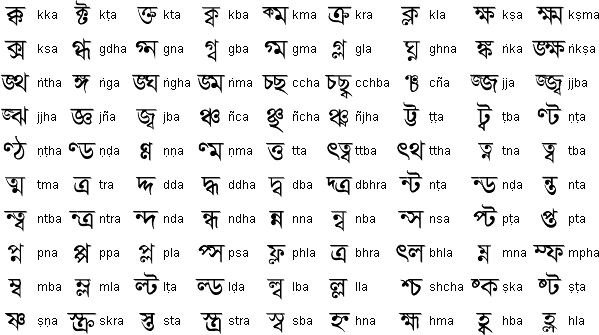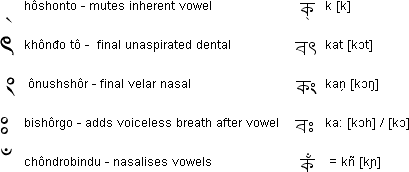|



| |
Bengali & Sylheti Translation Service
homepage.
..............................................................................................................................................
Bengali Script
[NOTE : Download & install Bengali fonts to be able to read the
following article properly]
Click here to view the evolving Bengali script
at different stages of history.
The Bengali
script
is an Abugida system of writing belonging to the Brahmic family of
scripts. Bangla Script grew out of Kutila, which was a reformed version of
Brahmi. Although the Brahmi script is believed to have evolved in the
ancient past, its earliest specimens are two inscriptions, dating from the
5th century BC, discovered at Pipraba and Bali. From 350-100 BC the Brahmi
script, now known as Ashoka or Maurya script, underwent certain
transformations. Asoka script or Maurya script can be divided into two
stages: ancient and modern. Ancient Maurya script had two forms: uttari
and daksini. Modern script evolved through seven stages. The second stage
in the evolution of the Brahmi script is into the Kushan script, named
after the Kushan royal dynasty and in use upto 100-300 AD. The third stage
of its evolution was into the Gupta script, named after the Gupta royal
dynasty, and current between the 4th and 5th centuries AD. During this
period, some letters of the Gupta script took the shape of modern Bangla
letters. For instance, in Maharaja Jayanatha's grant, B and M are similar
to the Bangla letters today.
The next stage in the evolution of the
Brahmi script was into the Kutila script, current between the 6th to 9th
centuries. The name perhaps comes from the fact that Kutila letters and
vowel symbols are rather complex (Kutila, meaning complicated). Almost all
modern scripts of Indic languages have grown out of the two main forms of
the Kutila script. Devanagari evolved from the west regional form of
north-Indian Kutila, while Bangla evolved from its eastern or Magadha
form. The transformation of eastern Kutila script began in the 6th century
AD. Some time during the reign of the Gurjara kings, most possibly during
the reign of Mahendrapala I, son of Bhoja, Kutila script entered Bengal.
The copperplate inscriptions of his son Vinayakapala, dating from the 10th
century AD, are in the Kutila script. Kutila script evolved further,
finally developing into the basic Bangla script towards the end of the
10th century AD. Specimens of this writing are to be found in the Bangad
grant of King Mahipala I (980-1036) and the Irdar grant of King
Nayapaladeva (1036-1053). The Bangad grant shows the following fully
developed modern Bangla letters: অ৴ উ৴ ক৴ খ৴ গ৴ চ৴ ঢ৴ ব৴ হ৴ ও, and
জ.
Click
here to view
the evolving Bengali script at different stages of history.
While it looks similar to
Devanagari, it is less blocky and presents a more sinuous shaping.
The modern script was formalized in 1778 when it was first typeset.
Clusters of consonants are
represented by different and sometimes quite irregular characters; thus,
learning to read the script is complicated by the sheer size of the full
set of characters and character combinations, numbering about 500.
The script
presently has a total of 11 vowel letters, used to represent the seven
main vowel sounds of Bengali, along with a number of vowel
diphthongs. Some of the vowel letters have different sounds
depending on the word, and a number of vowel distinctions preserved in the
writing system are not pronounced as such in modern spoken Bengali . For
example, the Bengali script has two symbols for the vowel sound "i" and
two symbols for the vowel sound "u". This redundancy stems from the time
when this script was used to write Sanskrit, a language that had a short
"i" and a long "i", and a short "u" and a long "u". These letters are
preserved in the Bengali script with their traditional names of
hrôshsho i (lit. 'short i') and dirgho i (lit. 'long i'),
etc., despite the fact that they are no longer pronounced differently in
ordinary speech.
Vowel signs can be used in
conjunction with consonants to modify the pronunciation of the consonant
(here exemplified by ক, kô). When no vowel is written, the vowel 'অ' (ô or
o) is often assumed. To specifically denote the absence of a vowel, a
hôshonto (্) may be written underneath the consonant.
Vowels
| Letter| |
Vowel sign with [kɔ] (ক)| |
Transliteration| |
Crudely corresp in
pronc to Eng |
| অ |
ক (none) |
kô and ko |
'a' as
in Ball |
| আ |
কা |
ka |
'u' as
in But |
| ই |
কি |
ki |
'ea' as in Tea |
| ঈ |
কী |
ki |
'ee' as in See |
| উ |
কু |
ku |
'oo' as
in Bool |
| ঊ |
কূ |
ku |
'oo' as in Cool |
| ঋ |
কৃ |
kri |
'ry' as
in Crystal |
| এ |
কে |
kê and ke |
'e' as
in Pet or a in Cat |
| ঐ |
কৈ |
koi |
oi |
| ও |
কো |
ko |
'o' as in Coca Cola |
| ঔ |
কৌ |
kou |
ou |
Modifiers
| Symbol |
Symbol with
[kɔ] (ক) |
Name |
Function |
| ্ |
ক্ |
hôshonto |
Suppresses the inherent vowel |
| ৎ |
কত্ |
khônđo
tô |
Final unaspirated dental-T
(ত) |
| ং |
কং |
ônushshôr |
Final velar nasal |
| ঃ |
কঃ |
bishôrgo |
Adds voiceless breath after vowel |
| ঁ |
কঁ |
chôndrobindu |
Nasalises vowel |
Consonants
| Letter| |
Name of
Letter| |
Represents the sounds
of (nearly) |
|
| ক |
kô |
k |
|
| খ |
khô |
kh |
|
| গ |
gô |
g |
|
| ঘ |
ghô |
gh |
|
| ঙ |
ungô, umô |
ņ |
|
| চ |
chô |
ch |
|
| ছ |
chhô |
chh |
|
| জ |
borgio
jô
(burgijjô) |
j |
|
| ঝ |
jhô |
jh |
|
| ঞ |
ingô, niô |
n (somewhat
nasalized) |
|
| ট |
ţô |
ţ ('t' as in Eng
'Toy') |
|
| ঠ |
ţthô |
ţth (no equiv in Eng
script) |
|
| ড |
đô |
đ |
|
| ঢ |
đhô |
đh |
|
| ণ |
murdhonno
nô
(moddhennô) |
n |
|
| ত |
tô |
t (dental-T; no equiv
in Eng script) |
|
| থ |
thô |
th |
|
| দ |
dô |
d ('th' as in Eng
'The') |
|
| ধ |
dhô |
dh |
|
| ন |
donto
nô
(dontennô) |
n |
|
| প |
pô |
p |
|
| ফ |
phô |
ph |
|
| ব |
bô |
b |
|
| ভ |
bhô |
bh |
|
| ম |
mô |
m |
|
| য |
ôntostho
jô
(ontostejô) |
j |
|
| র |
bôe shunno
rô |
r |
|
| ল |
lô |
l |
|
| শ |
talobbo
shô
(taleboshshô) |
sh |
|
| ষ |
murdhonno
shô |
sh |
|
| স |
donto
shô
(donteshshô) |
sh and s |
|
| হ |
hô |
h |
|
| য় |
ôntostho
ô
(ontosteô) |
y |
|
| ড় |
đôe shunno
ŗô |
ŗ (no Eng equiv
sound) |
|
| ঢ় |
đhôe shunno
ŗô |
ŗh (no Eng equiv
sound) |
|
Digits
|
Arabic
numerals |
0 |
1 |
2 |
3 |
4 |
5 |
6 |
7 |
8 |
9 |
|
Bangla
numerals |
০ |
১ |
২ |
৩ |
৪ |
৫ |
৬ |
৭ |
৮ |
৯ |
|
Bangla
names |
shunno |
êk |
dui |
tin |
char |
pañch |
chhôe |
shat |
aţ |
nôe |
| শুন্য |
এক |
দুই |
তিন |
চার |
পাঁচ |
ছয় |
সাত |
আট |
নয় |
A
selection of conjunct consonants

Modifier
symbols

Sample Text
[Article adapted from wikipedia and
other sources, modified suitably]
|


